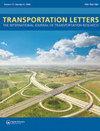A human-in-the-loop ensemble fusion framework for road crash prediction: coping with imbalanced heterogeneous data from the driver-vehicle-environment system
IF 3.3
3区 工程技术
Q2 TRANSPORTATION
Transportation Letters-The International Journal of Transportation Research
Pub Date : 2025-05-28
DOI:10.1080/19427867.2024.2392063
引用次数: 0
Abstract
Road accidents are an inevitable aspect of daily life, and predicting crashes is crucial for minimizing disruptions and advancing intelligent transportation technologies. This study aims to design an ensemble fusion decision system using various base classifiers and a meta-classifier to improve crash prediction efficiency within the driver-vehicle-environment system. We adopted a data-driven strategy to analyze four categories of features—driver demographics, vehicle telemetry, driver inputs, and environmental conditions—collected from a driving simulator. Optimized modeling strategies using AdaBoost, XGBoost, GBM, LightGBM, and CatBoost were implemented. Moreover, statistical logit models were also used to assess the likelihood of crashes and the correlations among key variables. Furthermore, three resampling strategies, SMOTE-TL, SMOTE-ENN, and ADASYN, were employed to address class imbalance. The best performance was achieved with GBM, XGBoost, and AdaBoost as base classifiers, SMOTE-TL for balancing, and CatBoost as the meta-classifier, with 89.78% precision, 95.69% recall, and 92.64% F1-score.
用于道路碰撞预测的人在环集合融合框架:应对来自驾驶员-车辆-环境系统的不平衡异构数据
道路交通事故是日常生活中不可避免的一个方面,预测交通事故对于最大限度地减少交通中断和推进智能交通技术的发展至关重要。本研究旨在设计...
本文章由计算机程序翻译,如有差异,请以英文原文为准。
求助全文
约1分钟内获得全文
求助全文
来源期刊

Transportation Letters-The International Journal of Transportation Research
TRANSPORTATION SCIENCE & TECHNOLOGY-
CiteScore
6.40
自引率
14.30%
发文量
79
审稿时长
>12 weeks
期刊介绍:
Transportation Letters: The International Journal of Transportation Research is a quarterly journal that publishes high-quality peer-reviewed and mini-review papers as well as technical notes and book reviews on the state-of-the-art in transportation research.
The focus of Transportation Letters is on analytical and empirical findings, methodological papers, and theoretical and conceptual insights across all areas of research. Review resource papers that merge descriptions of the state-of-the-art with innovative and new methodological, theoretical, and conceptual insights spanning all areas of transportation research are invited and of particular interest.
 求助内容:
求助内容: 应助结果提醒方式:
应助结果提醒方式:


